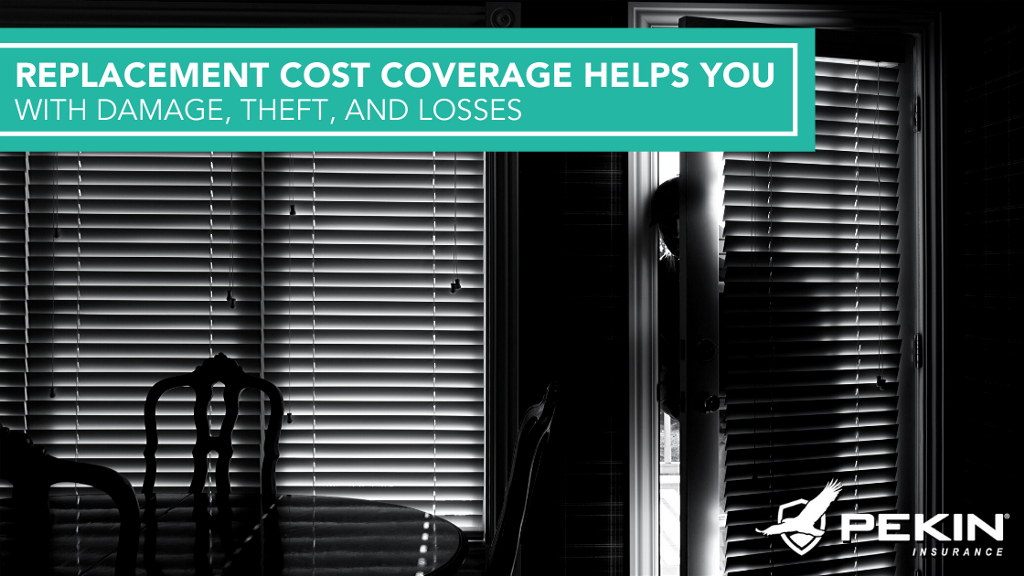How Replacement Cost Coverage Helps You With Damage, Theft, and Losses

You probably don’t think much about theft or property damage at your home. These aren’t the happiest subjects, but you’ll feel much better when you plan for them. Prepare for worst-case scenarios with replacement cost coverage!
First, Let’s Talk About Actual Cash Value
Actual cash value is also known as fair market value. Here’s an example to show how it works.
You come home and notice the door forced open. You turn on the lights and search the house.
You can’t find your laptop, and your stomach drops. You should file a police report and submit a claim with your home insurance carrier.
You bought the laptop for $800, but that was eight years ago. The amount you receive for the laptop will be determined by the cost to replace the device minus depreciation.
That’s another way of saying actual cash value gives you less than $800 for the laptop. In this scenario, you can’t buy a new, similar item without spending some of your own money.
How Is Replacement Cost Coverage Different?
Think of replacement cost coverage as an upgrade to actual cash value. Instead of receiving a partial payment for that laptop, you receive enough to replace it.
In other words, you get the amount it costs to purchase brand new items or rebuild your home.
Here’s how most home insurance policies work by default:
You have replacement cost coverage for the structure of your home.You have actual cash value coverage for the personal property in your home, like that laptop we mentioned. You can upgrade to replacement cost coverage for your personal property by adding an endorsement to your policy. Your agent will help you with that.
Some insurance carriers allow you to choose actual cash value coverage for the structure of your home. Do your homework before you take this route.
Replacement cost coverage could make your life a lot easier if you lose your home to a fire or tornado. Keep in mind, it pays for equivalents, not upgrades.
What do we mean by that?
You might live in a two-bedroom, two-bathroom home. Unfortunately, it’s declared a complete loss after a kitchen fire spreads to the entire structure.
Replacement cost coverage wouldn’t pay enough to build a mansion or replace your standard TV with a home theater system.
You should involve a contractor or appraiser if you need to replace your home after a catastrophe. They can give you accurate pricing for building materials and construction costs.
Steps to Take After a Loss
Here’s what to do after a homeowners loss:
Notify the insurance company or your insurance agent as soon as possible.
Contact the police if something’s been stolen.
Protect the property from further damage. You might need a contractor’s help for this step.
Cooperate with the insurance company. Provide prompt replies while they investigate the claim.
Provide an inventory of damaged personal property showing the quantity, description, actual cash value, and amount of loss. Attach all bills, receipts, and related documents that justify the figures in the inventory.
Why You Should Create a Home Inventory List
Things have a way of piling up. You could go years without sorting through your stuff, so there’s no better time than now!
A home inventory list is exactly what it sounds like. You use an app or pen and paper to document all your possessions.
This process works well when you go through one of the worst-case scenarios discussed above. You’ll have most, if not all, the information your insurance company will request.
Here’s what to do as you complete your home inventory.
1. Take Photos
Use your phone to take quick photos of the items you’re documenting.
2. Be Thorough
Update your list as you go from room to room. Or, group it into categories like appliances, clothes, and equipment.
Open all the cabinet doors. Count every spoon. Don’t forget the vacuum cleaner in the closet or the tools in the garage.
Everything adds up.
3. Get Behind Appliances
Record the serial numbers and model numbers of your electronics and appliances. Take care of some cleaning when you do this. Dust and clean behind appliances, then take a quick pic of all that information.
4. Figure Out What Not to Keep
Don’t put these items on the list if they’re going in a donation box or garbage can:
DVDs available on streaming servicesCDs gathering dustClothes that don’t fit youBroken electronicsMusical instruments no one plays (unless they’re collector’s items)Expired car seats (yes, they have expiration dates)
5. Take Note of Big-Ticket Items
Think about your special collections that might include:
CamerasComputersExpensive musical instrumentsJewelryArtFirearms
You should ask your agent about putting these items on a scheduled personal property policy. It extends coverage to valuables that wouldn’t be covered under a normal homeowners plan.
6. Share the Home Inventory With Your Agent
Keep your agent in the loop with your home inventory list. This really comes in handy when you deal with a loss.
Reach out to your local Pekin Insurance agent to put replacement cost coverage in place if you don’t have it. It could really come through when you need it the most.







